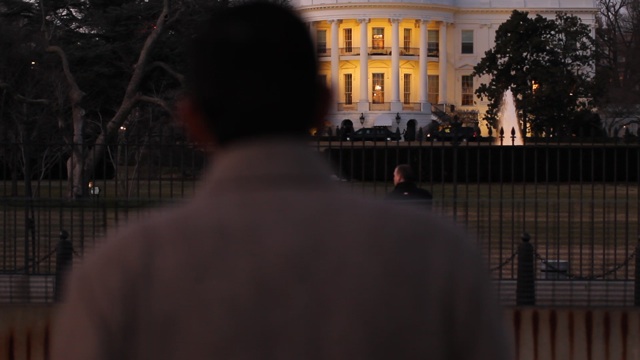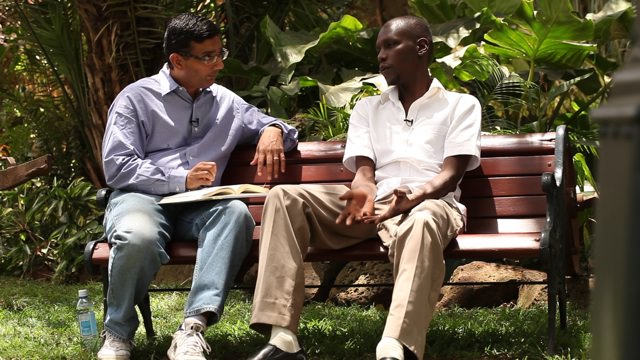Surpassed only by The Expendables 2, with Sylvester Stallone, the Dinesh D’Souza political documentary 2016: Obama’s America was the second-highest grossing movie in America the week that it opened in late August—timed to coincide with the Republican National Convention—and is now among the top ten highest earning documentaries in history. Mightily promoted by right wing talk radio hosts, 2016 had crossed over in a way that the distributor Rocky Mountain Picture’s previous release Atlas Shrugged: Part 1 did not; perhaps this was because, rather than fleshing out allegorical fiction, 2016 was concerned with the Manichean struggle happening today.
Like the RNC, 2016 (adapted from D’Souza’s 2010 best-seller The Roots of Obama’s Rage) is designed to show the president as a false prophet and a failed leader; unlike the RNC, the D’Souza film is less interested in the nature of Obama’s politics than in the enigma of his personality: “Love Him, Hate Him—You Don’t Know Him!” 2016 also seemed to promise a glimpse into the dystopian future should Obama be reelected. With the Democrats gathering in Charlotte to recapture the Obama story, I sought out 2016 on Labor Day afternoon at the Regal Union Square in Manhattan (after the movie had been mysteriously pulled from the Village East on Second Avenue) to learn more.
The day was overcast but not rainy and the theater was relatively full. There were some fifty people in the audience; it was a reasonably diverse crowd of middle-aged singles, some young couples, and only a few evident eccentrics, like the elderly gent who entered smiling in a checkered shirt and floppy sombrero. There were no disturbances (although one guy did have a box-cutter peeking out of his jeans pocket) and no outbursts, not even during the trailer for Hyde Park on the Hudson, starring Bill Murray as a twinkly FDR. I heard neither cheers, nor boos during the course of the ninety-minute movie—although Nancy Pelosi’s brief, giddy appearance in defense of Obamacare was greeted with derisive laughter.
When the movie was over, people filed out, mostly in silence. (I did, however, encounter an agitated knot of senior citizens: “It’s so scary,” a woman exclaimed to her five companions. “He’s taking us towards Communism.”) It seemed a subdued response to an intentionally alarmist movie. Perhaps some patrons, noting the “2016” in the movie’s title, were, like me, looking forward to a more lively, apocalyptic science-fiction concerning the nation’s first African-American president. There is a long Hollywood tradition wherein it’s the black guy who’s running the show when the universe is threatened with obliteration (The Fifth Element, 1997), the comet is hurtling towards earth (Deep Impact, 1998), the terrorists are running amok ( Fox TV’s 24, 2001-2010), the Rapture is upon us and Armageddon is nigh (Left Behind, 2005, and Solar Attack, 2006), the human race has devolved to moron status (Idiocracy, 2006), or the planet is beset by multiple cataclysms (2012, 2009).
But, disappointingly, directors D’Souza and John Sullivan save their Doomsday warning for the last fifteen minutes, after a montage showing D’Souza under attack by the clueless liberal media, mainly CNN’s talking heads. Then, with the volume rising on the staccato, faux Bernard Herrmann anxiety music, 2016 shows what will happen should Occupy Wall Street manage to reelect Obama, freeing him to pursue his true agenda—or rather that of his once-met, long-dead, feckless, fanatically anti-colonialist Kenyan father. 2016 is not without its horror elements: the Obama juggernaut is something like a conspiracy of one—led by a corpse.
As reinforced by the recurring image of an Obama stand-in prostrate before his father’s grave somewhere in the Kenyan bush, America is haunted by the Mau-Mau zombie of a “failed, Third World collectivism.” The president vindictively raises taxes, even on the poor (who are, after all, rich by Third World standards). At once socializing and destroying the US economy, he facilitates the transfer of wealth to Brazil and other points south. He embarks on unilateral nuclear disarmament amid worldwide nuclear proliferation and, most dramatically, by engineering America’s decline, enables the birth of a United States of Islam, visualized on a map as an algae-green mass engulfing Israel as it extends from Morocco to a region that could be Iran, or possibly Pakistan. In the clinching scene, a group of starry-eyed children led by an over-enthusiastic teacher sing an Obama campaign song as though it were the North Korean national anthem.
Too little, too late, too feeble by Hollywood standards. Actually 2016 is a personal documentary in the mode of Michael Moore’s Fahrenheit 9/11 or Bill Maher’s Religulous; it could more accurately have been called Obama and Me. D’Souza sets up Obama as his evil twin: they were born, graduated from an Ivy League college, and married in the same year! Their fathers both suffered the yoke of British colonial rule (and I wouldn’t have minded hearing a bit more about D’Souza’s). Their skin pigmentation, the filmmaker points out, is equivalent but the first to actually make it to the White House was D’Souza. He was a Reagan policy adviser when Obama was still doing whatever he was doing at Harvard. And, while working for Reagan, D’Souza did evidently learn something significant about US politics: Obama, he several times explains, was elected president mainly because America wanted to feel good about itself. 2016 is designed with a similar purpose in mind.
Advertisement
D’Souza is notably well-behaved. More deferential wonk rather than obnoxious showboat, he’s no Michael Moore, let alone a Sasha Baron Cohen. (He pulls no stunts when some of Obama’s Kenyan relatives send him packing.) Like David Maraniss, D’Souza has an obsessive interest in Obama’s background, but he’s less interested in revealing the arcana of family history than in theorizing about Obama’s political pathology. He is shown visiting Kenya, Jakarta, and Hawaii, interviewing one shrink and numerous pundits, uncovering associations (Bill Ayers, Edward Said, Frank Marshall Davis) and selectively quoting Obama’s memoir Dreams From My Father to make his argument that Obama is essentially and maybe even unconsciously the executor of his father’s creed. (The use of “from” rather than “of” in the book’s title is a crucial bit of evidence.)
D’Souza is not a birther; he doesn’t accuse Obama of being a secret Muslim (only a Muslim sympathizer). Rather, his Obama is a monstrous ingrate. The “rosebud” in D’Souza’s analysis is the so-called Churchill bust. During the Bush-Obama transition, a bust of Winston Churchill was removed from its spot in the Oval Office. According to the White House, this bust was, in fact, only a replica of the original one, then being restored, and, having been borrowed by the previous administration, was necessarily returned by the incoming one, to the British government; it’s place was taken by a bust of Abraham Lincoln and, consequently, the restored Churchill bust was relocated outside the White House “Treaty Room.”
D’Souza seizes upon this bit of bureaucratic interior decorating, which he considers Obama’s first official act, as an example of the “baffling behavior” he will spend much of the movie explicating. Obama busted: substituting Lincoln for Churchill is evidence of the president’s internalized anti-British bias—something the Mumbai-born filmmaker acknowledges existed in his own family. D’Souza’s fear of Brit-bashing is fascinating. Has he any awareness of Irish-American attitudes? Ever seen one of those Biblical spectacles where the Christians are played by Americans and the Romans are Brits? What did he make of candidate Romney’s overt disdain for his British hosts during the London Olympics? Where does he think the Tea Party got its name?
No less than Obama—and perhaps quite a bit more—D’Souza is loath to give offense to what he seemingly regards as America’s dominant culture. Indeed, one might just as easily interpret the entirety of 2016 as evidence of D’Souza over-compensation with regards to his feeling of post-colonial, Third World inferiority. The proof: the bizarre shot the filmmaker includes in which, while on his fact-finding mission to Hawaii, he can be glimpsed half-heartedly trying to learn the hula—presenting himself as a more acceptable Obama, under the skin.




